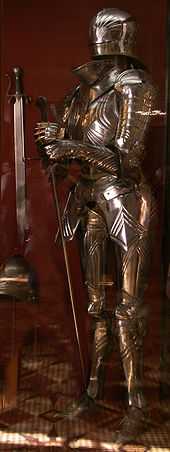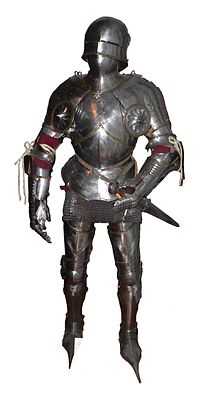Gothic plate armour

Gothic plate armour (German: Gotischer Plattenpanzer) is the term for the type of steel plate armour made in the Holy Roman Empire during the 15th century.
The term Gothic refers to the characteristic "German" style of this armour, specifically its decoration with fluting or ridges imitating the fashion in dress of the period, while it was functionally very similar to French, Italian or English plate armour of the same period.
The most elaborate examples of Gothic-style armour were produced after the end of the Gothic period proper, during the German Renaissance (first half of the 16th century), but this type is more specifically classed as Maximilian armour. According to this nomenclature, Gothic armour proper was worn during the later 15th century, a transitional type called Schott-Sonnenberg style was current during c. 1500 to 1515, and Maximilian armour proper during 1515 to 1525.
Gothic armour was often combined with a Gothic sallet, which included long and sharp rear-plate that protected the back of the neck and head. Maximilian armour of the early 16th century is characterized by rounder and more curved forms, and their ridges were narrower, parallel to each other and covered the entire armour.
Methods of single combat in this type of armour are treated in the German fencing manuals of the period, under the term Harnischfechten ("armoured combat").
Pictures
-

Breakdown of individual components of Gothic armour
-

Gothic helmets, illustration by Viollet Le-Duc
-
.jpg)
Close-up on Gothic armour, flutes and ridges are visible along the armour
-

Maximilian Gothic armour
-

Gothic plate armour, from a German book illustration published 1483
References
| Wikimedia Commons has media related to Gothic armour. |